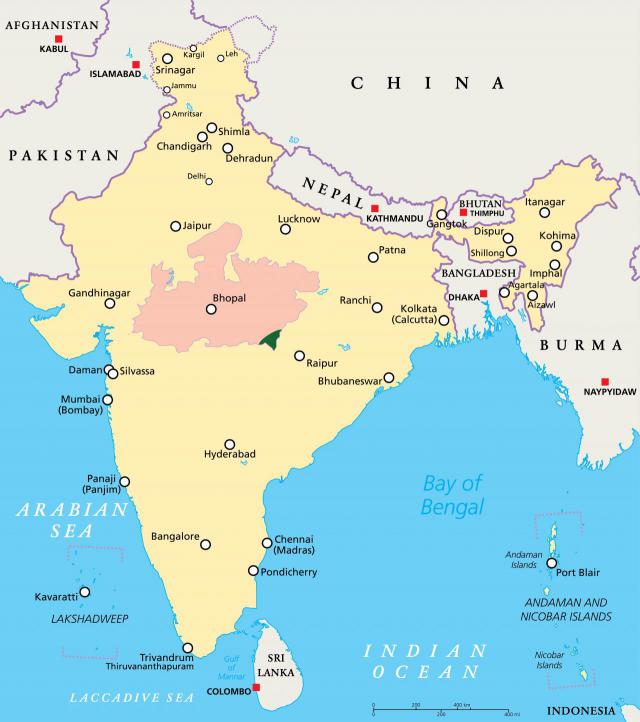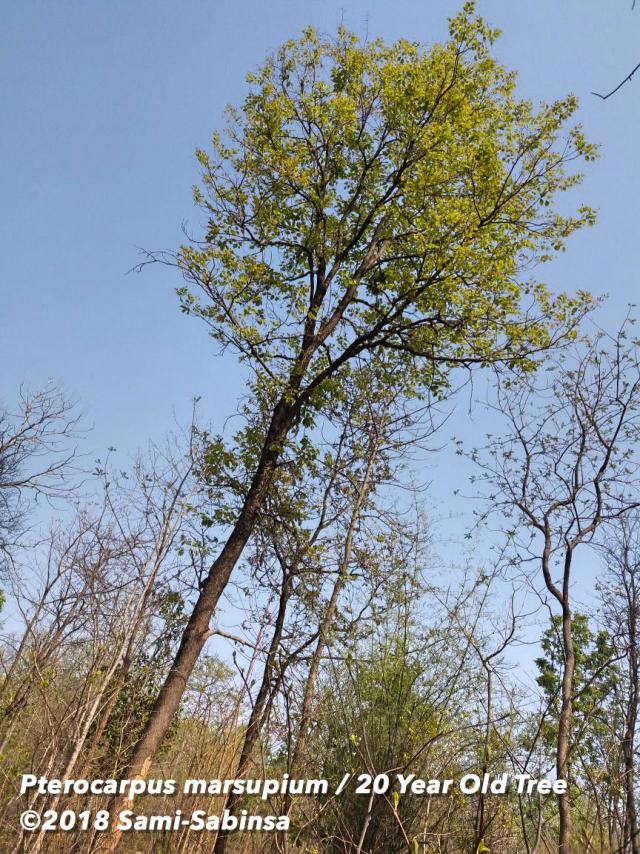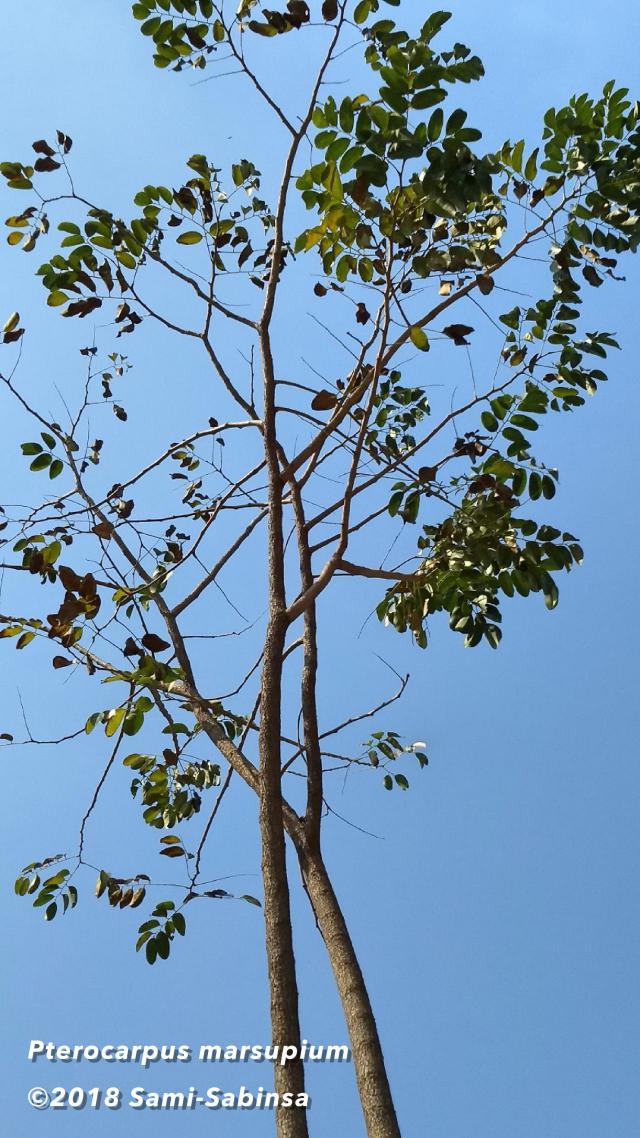The Sami-Sabinsa Group* has committed to
fund a 10-year reforestation project that will oversee the planting of more
than 166,600 Indian kino (Pterocarpus
marsupium, Fabaceae) trees on 250 acres in the large central Indian state
of Madhya Pradesh.1 The group expects to spend about $500,000 on the
project, which it claims is the first initiative to conserve this high-value, multipurpose,
threatened species in India. The project earned the NutraIngredients-USA
Editors Award for Industry Initiative of the Year for 2018.2 The Indian
kino tree has been used in India’s traditional medicine system of Ayurveda, and
kino wood  extracts have demonstrated antidiabetic properties (see “About the
Indian Kino Tree” sidebar). extracts have demonstrated antidiabetic properties (see “About the
Indian Kino Tree” sidebar).
“While there have been some initiatives by
Indian forest departments for propagating teak and other timber trees, an
initiative for the cultivation of the Indian kino tree has hardly been done by
government agencies or private enterprise,” wrote Shaheen Majeed, president of
Sabinsa Worldwide. “Natural populations of this tree have been greatly reduced,
and often no young saplings can be found in the forest” (email, June 6, 2018).
The Sami-Sabinsa Group produces two
proprietary standardized ingredients from the heartwood† of the Indian kino
tree: Silbinol, a pterostilbene-enriched fraction of the ethanol extract of the
heartwood, and pTeroSol, a
C-glycosides-enriched fraction of the aqueous extract of the heartwood.3
The reforestation project was started with the expectation that these products
will increase demand for this already-threatened species.
“When Sabinsa looked into supplies with an
eye to the future, we found that this tree’s population was declining, and it
was neglected,” wrote Majeed. “The Sami-Sabinsa Group has focused on
cultivation, propagation, and conservation of medicinal plants for more than 20
years, and been involved in symposia discussing how traditional Indian plants
should be protected, but this program illustrates even longer-term thinking,
beyond meeting Sabinsa’s supply needs.”
Suma Tagadur, an assistant professor at the
University of Trans-Disciplinary Health Sciences and Technology (TDU), thinks
this initiative should be appreciated and replicated for other Indian
botanicals. “Certainly it will reduce pressure on the wild genepool of the
species,” she wrote, and added that such initiatives should be encouraged by
forest departments and the National Medicinal Plants Board of India (email,
July 9, 2018). She said that similar programs could be undertaken for other
important species in the region, including the ashoka tree (Saraca asoca,Fabaceae), red sanders (Pterocarpus santalinus, Fabaceae), and false
calumba (Coscinium fenestratum, Menispermaceae). Fabaceae), and false
calumba (Coscinium fenestratum, Menispermaceae).
The Indian kino tree is considered Near
Threatened according to the Red List criteria of the International Union for
Conservation of Nature (IUCN). This is based on a 2017 assessment that used version
3.1, the current version, of the Red List
Categories and Criteria. According to the IUCN, “a taxon is Near Threatened
when it has been evaluated against the criteria but does not qualify for
Critically Endangered, Endangered or Vulnerable now, but is close to qualifying
for or is likely to qualify for a threatened category in the near future.”4-5
Previously, based on a 1998 assessment that used an earlier version of the Red List Categories and Criteria (version
2.3), the Indian kino tree was considered Vulnerable.4 The IUCN’s Red List of Threatened Species is the
world’s most comprehensive information source on the conservation status of
plant, animal, and fungal species. The Red
List Categories and Criteria provides an explicit, objective framework for
classifying species at high risk of global extinction, based on parameters such
as population reduction and restricted geographic range. According to Majeed,
one of the goals of the Sami-Sabinsa Group’s new project is to prevent this
autogenic-reproductive-deficient species** from qualifying for one of the IUCN’s
three threatened categories (i.e., Vulnerable, Endangered, or Critically
Endangered) again.
Also using version 2.3 of the IUCN
criteria, the Foundation for Revitalization of Local Health Traditions (FRLHT),
a Bengaluru-based medicinal plant conservation organization, evaluated Indian kino
tree populations in six states in India (Table 1).
Table 1: Threat Status
of Pterocarpus marsupium in Six
Indian States*
|
Indian State
|
Threat Status (Assessment
Year)
|
|
Chhattisgarh
|
Vulnerable (2003)
|
|
Madhya Pradesh
|
Vulnerable (2003)
|
|
Maharashtra
|
Vulnerable (2001)
|
|
Odisha
|
Endangered (2007)
|
|
Rajasthan
|
Critically Endangered (2007)
|
|
West Bengal
|
Endangered (2007)
|
*Based on the FRLHT’s assessments using
IUCN criteria.6
The Indian kino tree has a wide native
range and occurs across much of India and Sri Lanka, as well as in Nepal,
Bangladesh, and Taiwan. It grows at elevations up to about 1,200 meters (3,937
feet) in moist and dry deciduous forests and in hilly areas. The species
prefers deep, well-drained, low-fertility soils and abundant light. The status
of populations across the species’ range is not fully known, however. The Indian
kino tree reportedly is declining in Sri Lanka, and field observations in India
suggest that populations there are probably small. Furthermore, the plant’s range
overlaps with some areas where the Global Forest Watch considers there to have
been a 30% loss of tree cover since 2000.4
The reforestation project will take place
on a 250-acre plot of land, located in the districts of Seoni and Balaghat in
the southeastern part of Madhya Pradesh, which was provided and is owned by the
government of Madhya Pradesh. According to Majeed, the Madhya Pradesh Forest
Department is also concerned about the conservation status of the Indian kino
tree, and the Sami-Sabinsa Group’s initiative is well-regarded by the
government.
The project officially began in March 2018
when the Sami-Sabinsa Group entered into a memorandum of understanding with the
Forest Department. Seedlings are being grown in nurseries, and planting was done
in July 2018, when monsoon season was in full effect. Cultivation will be
managed by the reforestation organization Madhya Pradesh Rajya Van Vikas Nigam
Ltd., which was incorporated in 1975 and is funded by the state government of
Madhya Pradesh and the government of India. Van Vikas Nigam
Ltd., which was incorporated in 1975 and is funded by the state government of
Madhya Pradesh and the government of India.
The plantation will be monitored constantly
for five years, and trees will be replaced if there is any mortality. After
five years, the trees will be self-sustaining. It was determined that 166,600 trees is the maximum number that the
250-acre plot can support. Since Indian kino trees are deciduous trees that
usually have straight boles, the trees should initially be able to thrive in
the allotted space, according to Majeed, but thinning will be required after 10
years. After 15 to 20 years, the Forest Department may decide
about the harvesting of selected trees.
“For each hectare of land, it is estimated
that 999 man-days will be required for plantation and maintenance of the trees
for a period of 5 years,” Majeed wrote. “The clearing of undergrowth in the
forest land, while preserving fruit-bearing and other desirable trees on the
five meters around the periphery, has been done. The trees will be monitored
regularly to make sure they are taking root and starting to thrive.”
According to Majeed, many initial
challenges associated with the project have been overcome already, such as
finding the cultivation partner and getting the government to provide the land.
“While there is concern that the trees may be poached before they are mature,
the area has been wire-fenced and will be under supervision,” Majeed wrote. “Unwanted
interference and/or forest devastation should not occur to disturb this ongoing
project. Any soil concerns and potential pathogens will be strictly observed by
our scientists, botanists, and agro-specialists, and remedied immediately.”
The plot is located near forests where the
Indian kino tree currently grows. A variety of other medium-sized and large
tree species also grow in these areas, including Butea monosperma (Fabaceae), Dalbergia
spp. (Fabaceae), Ficus religiosa (Moraceae),
Lagerstroemia spp. (Lythraceae), Schleichera oleosa (Sapindaceae), Syzygium cumini (Myrtaceae), and Terminalia spp. (Combretaceae). According to Majeed, tinsa (Desmodium oojeinense, Fabaceae) and sheesham (Dalbergia sissoo,
Fabaceae) often are found as  key associates of the Indian kino tree. key associates of the Indian kino tree.
In Madhya Pradesh, the Indian kino tree has
been used primarily as a source of timber, according to Majeed. “Our focus is also on the better availability
of the compound of our interest,” he wrote. “Considering the species’ low
germination rate, Sami-Sabinsa with the Forest Department is identifying
pterostilbene-rich chemotypes of Pterocarpus marsupium. After
evaluation, the selected chemotypes will be taken up for micropropagation. We
expect this value addition will have a great impact on the conservation of the species
in general and the elite chemotypes in particular.”
This project is
part of the Sami-Sabinsa Group’s larger commitment to sustainability. “The
industry, or parts of it, has struggled to address growing challenges in
sourcing of botanical ingredients in the face of increased demand, climate
change, inadequate protection of indigenous species, and sometimes questionable
agricultural practices,” Majeed wrote. “Sabinsa’s well-established
cultivation program contracts directly with farmers in rural India, ensuring
income for the small farmers, supporting schools, and improving rural
infrastructure. Sabinsa is replicating this successful program in other
countries, because the impact of climate change on weather patterns will create
the necessity of sourcing in different regions.”
Majeed hopes
this effort, which is unique because it intends to proactively prevent
shortfalls in supplies of this species ahead of anticipated future demand, will
serve as a model. “There
are declining species around the world, and the effects of climate change are
already exacerbating vulnerabilities created by exploitation without
replanting,” he wrote. “As far as we know, this venture is the first of its kind
in the dietary supplements industry. It goes beyond farms and into the forest.
We hope that it will inspire other similar programs. We have already had other
government entities in India take notice of our efforts, and we are in
discussions for greater conservation efforts for this species as well as other threatened
species in and around India. This collaboration model can be replicated by
other companies and in other countries. We hope it will be.”
—Connor Yearsley
|
About the Indian Kino Tree
The Indian kino tree, also called vijayasar in Hindi and asan in Sanskrit, is a perennial,
tropical, deciduous tree in the legume (Fabaceae) family that can grow to 30
meters (98 feet) tall. Its leaves are imparipinnate (i.e., leaflets are
arranged on either side of the rachis and there is an unpaired terminal
leaflet) and alternate (i.e., a single leaflet is attached alternately on the
rachis). Its leaflets are elliptic-ovate or oblong in shape. From about June
to August, the tree produces showy golden yellow flowers in panicles (loose,
branching flower clusters). Its pods are orbicular, flat, and winged, each
with one to two seeds.7-9
The tree’s timber can be used for
plywood, veneer, poles, tools, furniture, containers, boats, musical
instruments, and more.10 In fact, the species has been described
as one of the most “multipurpose forest trees.”4 However, unlike
species that are valued primarily for their fruit, leaves, or flowers, ,
which can be harvested without killing the entire plant, the Indian kino tree
mostly is valued for different parts of its trunk (e.g., the heartwood), so
human use usually requires harvesting the entire tree. This creates concerns
about the sustainability of the species.
It has been proposed that a population
census be conducted across the Indian kino tree’s range, its international
trade be monitored, and harvest quotas be introduced.4 According
to Majeed, the sustainable management of valuable trees, including this
species, requires longer-term thinking than for other plants, because trees
have longer life cycles.
According to the Indian Materia Medica (1908): “Kino is a simple astringent,
administered in diarrhea; somewhat milder in action than catechu, therefore
better adapted for females and children. Gum is used for toothache.”11
The red exudate, called kino gum, which is yielded when incisions are made
through the bark up to the cambium layer, contains kino tannic acid and has
astringent properties.12
The stem bark
of the Indian kino tree is used in ethnomedicines in India for diabetes,
anemia, asthma, body pain, digestive disorders, diarrhea, dysentery, herpes,
skin diseases, toothache, leukorrhea, and dysmenorrhea. 13
Kol tribes in Odisha, India, reportedly
have made a paste mixture from the bark of the Indian kino tree and the barks
of mango (Mangifera indica,
Anacardiaceae), sal tree (Shorea
robusta, Dipterocarpaceae), and
Spondias pinnata (Anacardiaceae) to
treat dysentery. In addition, the Kannada people reportedly have made wooden
tumblers (drinking vessels) from the yellowish-brown heartwood of the tree.
The tumblers are then filled with water that is allowed to sit overnight,
which creates an extract of the heartwood that is drunk the next morning to
treat diabetes.7
Epicatechin,
found in the bark and heartwood of the tree, is chemically similar to insulin
but reportedly works through a different mechanism of action.14 In
diabetic rats, epicatechin has been shown to be able to regenerate pancreatic
beta cells, which release insulin.12 In addition, in one study,
marsupin and pterostilbene from the heartwood of the tree performed
comparably to the conventional diabetes drug metformin in reducing blood
glucose levels in hyperglycemic rats.8 In another study, the
Sami-Sabinsa Group’s pTeroSol extract lowered blood glucose and HbA1c levels
and increased insulin levels in diabetic rats. Oxidative stress and
inflammatory markers also were reduced in this study.15
|
* Bengaluru, India-based Sami Labs,
founded in 1991, is a manufacturer and exporter of herbal extracts and other
natural products. It is the parent company of Sabinsa Corporation, which was
founded in 1988 and is a manufacturer, supplier, and marketer of herbal
extracts, dietary ingredients, and other natural products for the nutritional,
cosmetic, pharmaceutical, and food industries. Sabinsa has offices around the
world with US headquarters in East Windsor, New Jersey. The companies often are
referred to as the Sami-Sabinsa Group because they are under the same ownership
and both companies contribute to many of the same initiatives.
† The
heartwood is the older, harder, nonliving inner wood of the trunk that is
usually darker, denser, less permeable, and more durable than the surrounding
sapwood.
** According to Majeed, an
autogenic-reproductive-deficient species is one in which “reproduction is low
due to self-generated and biotic factors.” The Indian kino tree has a low
germination rate (14-20%) and “early development of seedlings is hampered” by
various factors, such as competition from weeds or thick grass. Also, young
roots are vulnerable to rot, and most of the tree’s pods fall during the hot
season and may be damaged by fire.
Image credits (top to bottom): Map of India, with the green portion indicating the planting area. Image courtesy of Sami-Sabinsa.
A 20-year-old kino tree. Image courtesy of Sami-Sabinsa.
Kino illustration by Franz Eugen Köhler from Köhler's Medizinal-Pflanzen, 1896.
Kino tree. Image courtesy of Sami-Sabinsa.
References
- Sami-Sabinsa Group to Fund Reforestation of Pterocarpus marsupium in India. Sabinsa
website. Available at: www.sabinsa.com/media-coverage/1030-sami-sabinsa-group-to-fund-reforestation-of-pterocarpus-marsupium-in-india.
Accessed June 20, 2018.
- NutraIngredients-USA Awards: And the WINNERS are…
NutraIngredients-USA website. July 17, 2018. Available at: www.nutraingredients-usa.com/Article/2018/07/17/NutraIngredients-USA-Awards-And-the-WINNERS-are.
Accessed August 15, 2018.
- Standardized Phyto Extracts. Sabinsa website. Available
at: www.sabinsa.com/products-and-services/standardized-phytoextracts.
Accessed June 20, 2018.
- Pterocarpus
marsupium. IUCN website. Available at: www.iucnredlist.org/details/34620/0.
Accessed June 20, 2018.
- 2001 Categories & Criteria (version 3.1). IUCN
website. Available at: www.iucnredlist.org/static/categories_criteria_3_1.
Accessed June 20, 2018.
- Plant Details for Pterocarpus
marsupium. FRLHT website. Available at: envis.frlht.org/plantdetails/bd8af322cb239ac4abbd3757d951f4e1/1f980ac8d3cb2382540571ad873491ae.
Accessed August 15, 2018.
- Pterocarpus
marsupium. Encyclopedia of Life website. Available
at: eol.org/pages/643242/details#cite_note-6.
Accessed June 20, 2018.
- Subramoniam A. Anti-Diabetes
Mellitus Plants: Active Principles, Mechanisms of Action and Sustainable
Utilization. Boca Raton, Florida: CRC Press; 2016.
- Sahoo S, Ramesh DB, Rao YR, Debata BK, Misra VN, eds. Conservation and Utilization of Medicinal
and Aromatic Plants. New Delhi: Allied Publishers Ltd.; 2001.
- Bijasal (Pterocarpus
marsupium). International Tropical Timber Organization website. Available
at: www.tropicaltimber.info/about/.
Accessed June 20, 2018.
- Nadkarni KM, ed. Indian
Materia Medica. Bombay: Popular Prakashan Private Ltd.; 1908.
- Khare CP. Ayurvedic
Pharmacopoeial Plant Drugs: Expanded Therapeutics. Boca Raton, Florida: CRC
Press; 2016.
- Jain V, Jain SK. Compendium of
Indian Folk Medicine and Ethnobotany (1991 – 2015). New Delhi: Deep
Publications; 2016.
- Mechanism of Action. Silbinol
website. Available at:www.silbinol.com/about/action-mechanism/.
Accessed June 20, 2018.
- Sabinsa’s
pTeroSol Pterocarpus marsupium extract studied in published research for
diabetic benefit. Sabinsa website. February 19, 2018. Available at: www.sabinsa.com/press-release-2018/1019-sabinsa-pterosol-pterocarpus-marsupium-extract-studied-in-published-research-for-diabetic-benefit.
Accessed June 20, 2018.
|